Additions to the floral wealth of Sirmaur District, Himachal Pradesh from Churdhar Wildlife Sanctuary
S.P. Subramani 1, K.S. Kapoor 2 & G.S. Goraya 3
1,2,3 Himalayan Forest Research Institute (HFRI), Conifer Campus, Panthaghati, Shimla, Himachal Pradesh 171009, India
1 Present Address: Institute of Forest Genetics and Tree Breeding (IFGTB), Forest Campus, R.S. Puram, Coimbatore, Tamil Nadu 641002, India
3 Present Address: Deputy Director General, Indian Council of Foretry Research & Education (ICFRE), Dehra Dun, Uttarkhand 248006, India
1 subramanisp@icfre.org (corresponding author), 2 kapoorks@icfre.org, 3 gurinder9@hotmail.com
Abstract: A total of 352 species of phenerogams comprising 251 dicotyledons, 97 monocotyledons and four species of gymnosperms belonging to 85 families collected from Nohra Forest Block of Churdhar Wildlife Sanctuary, District Sirmaur, Himachal Pradesh are reported as additions to the district. This includes 13 threatened species under different Red List assessments, both global and regional and 35 species are endemic to western Himalaya.
Keywords: Additions, Churdhar, flora, Himachal Pradesh, protected area, Sirmaur.
doi: http://dx.doi.org/10.11609/JoTT.o2845.6427-52
Editor: K. Ravikumar, FRLHT, Bengaluru, India. Date of publication: 26 October 2014 (online & print)
Manuscript details: Ms # o2845 | Received 24 June 2011 | Final received 01 September 2014 | Finally accepted 23 September 2014
Citation: Subramani, S.P., K.S. Kapoor & G.S. Goraya (2014). Additions to the floral wealth of Sirmaur District, Himachal Pradesh from Churdhar Wildlife Sanctuary. Journal of Threatened Taxa 6(11): 6427–6452; http://dx.doi.org/10.11609/JoTT.o2845.6427-52
Copyright: © Subramani et al. 2014. Creative Commons Attribution 4.0 International License. JoTT allows unrestricted use of this article in any medium, reproduction and distribution by providing adequate credit to the authors and the source of publication.
Funding: Self funded.
Competing Interest: The authors declare no competing interests.
Acknowledgements: The authors are thankful to the Director, Himalayan Forest Research Institute, Shimla for allowing us to use the related facilities and for encouragement during the study. Besides, we express our gratitude to Shri Vinay Tandon, IFS, PCCF Himachal Pradesh State Forest Department, Shimla for granting permission. We are also thankful to the Head, Botany Division FRI, Dehra Dun for providing all facilities at DD Herbarium, Dehra Dun during the matching of the voucher specimens. Help rendered by Dr. Vaneet Jishtu, Sh. Purushotham Ram and Dushyant Kumar at different stages of the study is thankfully acknowledged.

Protected areas (PAs) like wildlife reserves and national parks, cover more than 12% of the Earth’s surface and are internationally recognized as a major tool in conservation programmes (Khan & Bhagwat 2010). They maintain key habitats, provide refugia, allow species migration and movement and provide goods and services otherwise essential for sustainable use of natural resources. As a result, they store more than 15% of the terrestrial carbon (Holdgate 1999) and also serve as a tool for containing future exceptional loss of habitat. Accordingly, it has now been realized that inventorisation of plants occurring in such areas is absolutely necessary and so are the initiatives from the Ministry of Environment, Forests, & Climate Change, Government of India, which is now showing great concern for compilation or documentation of floral elements in these areas of importance, ultimately leading towards ensuring the welfare of faunal elements. Though 20177 taxa of flowering plants have been reported from India (Karthikeyan 2009), several areas still remain under-explored and pockets of many forests botanically less studied.
Churdhar Wildlife Sanctuary (CWS) is one of the few remaining citadels of biodiversity that covers wide altitudinal ranges where documentation is certainly inadequate. However, some parts of this sanctuary face heavy threats from a comparatively high density of livestock population belonging to the Gujjar community, residing in the area alongwith their herds for grazing purposes since long. Besides, visits of thousands and thousands of pilgrims annually to Chooreshwar Mahadev Temple at Chur peak—a religiously important place—is adding towards the voes since populations of a few species like Angelica glauca, Betula utilis, Cypripedium cordigerum, C. himalaicum, Dactylorhiza hatagirea, Rhododendron anthopogon, R. campanulatum, Taxus wallichaiana and Valeriana jatamansi etc. are in rapid decline during the recent decades.
Botanical explorations of Royle in 1823, Drummond during 1883–1885 and Clarke in 1884, as carried out in the past are some of the pioneering works from Chur Mountains. During the 19th century Collett (1902), and Nair (1977) also made pilot surveys in this area. However, these two studies covered only the Pulbahal Forest Block of the sanctuary falling in Shimla District, Himachal Pradesh. Studies undertaken here in the recent past include the works of Gupta (1998) and Kumar (2004) but they recorded only the medicinal flora of the sanctuary. The first published account on the flora of Sirmaur District is of Kaur & Sharma (2004), wherein they reported 911 species belonging to 544 genera under 139 families again only touching the boundaries of the sanctuary and its core area.
The present study had been carried out systematically for assessing the floristic wealth of Churdhar Wildlife Sanctuary including its rich potential of herbal medicinal plants. However, in this paper only Nohra Block of the sanctuary and the additions to the flora of district Sirmaur have been highlighted.
Study Area
Churdhar Wildlife Sanctuary—one of the important protected areas of the Himalayan region—is located in the Trans-Giri hill ranges of Sirmaur and Shimla districts in the state of Himachal Pradesh. The sanctuary which falls around Chur Peak (3,647m), one of the Shivalik’s highest summits in sub-tropical Himalaya, was established in the year 1985 with a view to preserve the biological wealth and floral diversity in the Panchmuda Range of Churdhar. The sanctuary comprises an approximate area of 66.70km2 with wide altitudinal ranges varying from approximately 1900–3647m and lies in between 30048’37”–30054’39”N & 77023’32”–77029’49’’E. From a management point of view, the sanctuary area has been divided into two forest blocks namely, Nohra and Pulbahal. Approximately, 65% of the study area falls in Nohra Block that has three forest beats, i.e., Nohra, Churas and Chhog Thali falling in Sirmaur District (Fig. 1) whereas the remaining 35% of the sanctuary area is in Pulbahal Block which has two forest beats namely Sarpat and Bharog and forms a part of district Shimla (Anonymous 1994–1995; Anonymous 2005–2006). Based on the altitude, aspect and climatic conditions, the sanctuary harbours a wide array of vegetation types ranging from anthropogenic grasslands in lower hill ranges to alpine meadows in the mountain peaks whereas the oak forests, moist deodar forests and western mixed conifer forests occupy the major portion of the middle hill ranges. Because of its rich floral elements in distinct altitudinal zonations including good faunal wealth, the area is spectacular and is quite important for detailed investigations.
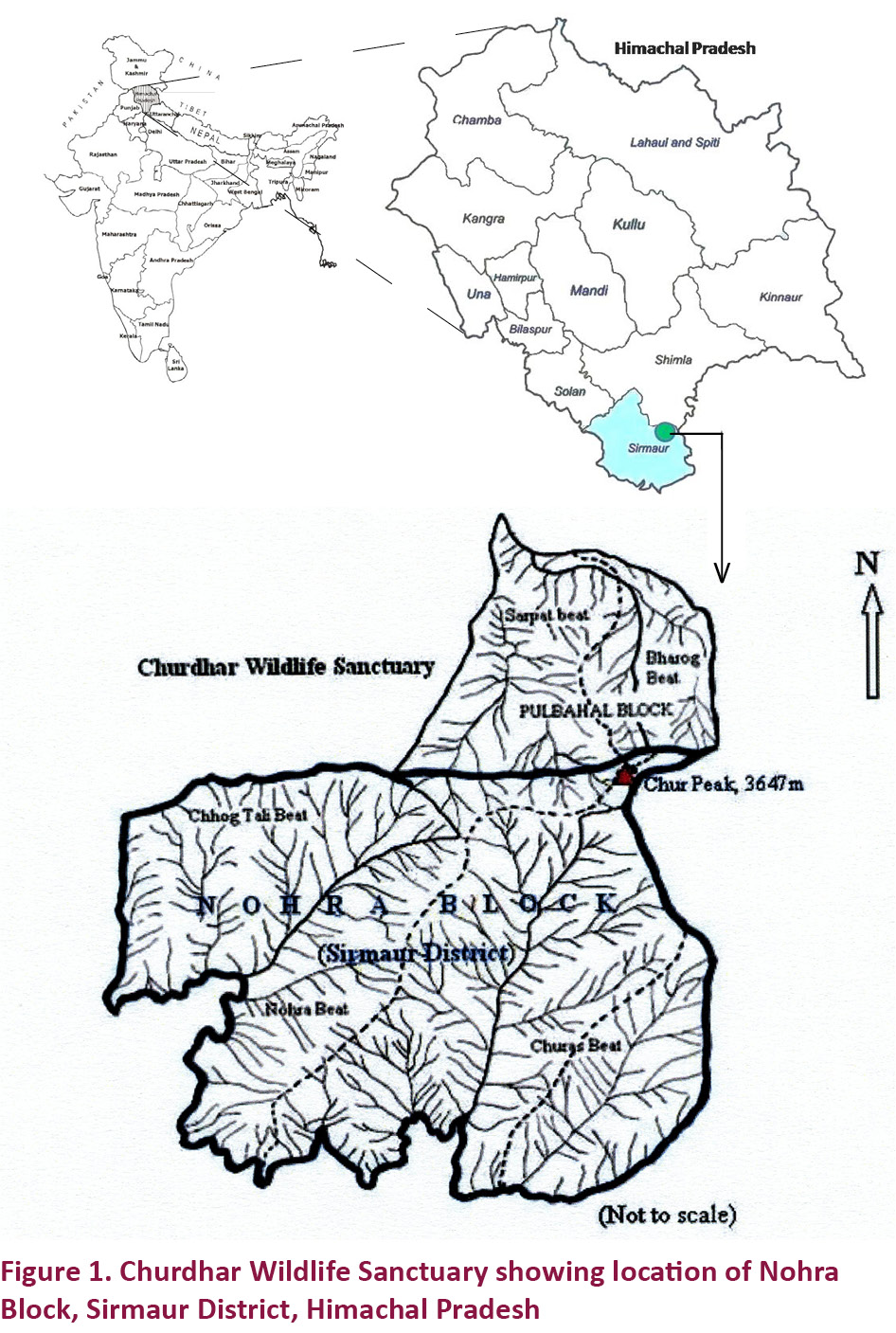
Material and Methods
For complete botanical explorations and phyto-sociological studies for quantification of the floristic elements in different altitudinal zonations of the sanctuary, periodic field trips were undertaken starting from March 2002 till September 2008 in different forest types including macro- and micro-habitats. The voucher specimens thus collected, were identified using local Floras (Chowdhery & Wadhwa 1984; Polunin & Stainton 1984; Collett 1902; Kaur & Sharma 2004) and species indentity was further confirmed by comparing the authentic specimens housed in DD Herbarium of Forest Research Institute and Herbarium of Botanical Survey of India, Dehra Dun. Families of the specimens are arranged following Bentham and Hooker’s classification and under each family, species were arranged alphabetically with their recent botanical name, habit, flowering season, forest area and altitudinal zonations. During the process of verification of herbarium specimens and their screening with existing literature for their earlier records many taxa collected from Nohra Block of Sirmaur area as highlighted in the present attempt, turned out to be new additions to the flora of district Sirmaur, Himachal Pradesh. Voucher specimens for each species are also deposited in the herbarium of Himalayan Forest Research Institute (HFRI), Shimla.
Results and Discussions
A total of 793 taxa with 748 angiosperms, eight gymnosperms and 37 pteridophytes belonging to 431 genera distributed under 143 families were collected during the survey period. A further scrutiny of the literature revealed that out of the total 756 species of phenerogams, 352 species representing 251 dicotyledons, 97 monocotyledons and four species of gymnosperms spread over to 85 families were hitherto unreported from district Sirmaur, Himachal Pradesh (Table 1). In this paper the floral elements from Nohra Block of CWS has been listed which forms new records for Sirmaur District, Himachal Pradesh. Kaur & Sharma (2004) in their earlier studies had documented only 911 taxa from district Sirmaur having a total geographical area of 2,825km2, whereas, the outcome of the present intensive botanical investigation in CWS alone has yielded 756 taxa of flowering plants and conifers within the 66.70km2 area of the sanctuary. It clearly reflects that this particular sanctuary is the citadel of plant diversity and accordingly, a number of plant lovers in the past, appreciated its ecological importance and subsequently developed an interest in this area, though they did not have much of the scientific data to explain its relevance. Hence, the present study besides, providing the firm scientific footing to the earlier accounts, has further pointed out that the focused approach for the management of the sanctuary is essentially required from its conservation point of view.
In this enumeration as carried out in the sanctuary, the dominant 10 families are Poaceae followed by Asteraceae, Orchidaceae, Cyperaceae, Ranunculaceae, Scrophulariaceae, Apiaceae, Papilionoideae, Rosaceae and Caprifoliaceae which contribute 45% of the total collections (Fig. 2). Though the habit of plants are exhibited in all life forms, herbaceous habit was found to be the most dominant among others, followed by shrubs, trees, climbers and others as shown in Fig. 3.
Out of the total 352 species, 35 taxa, viz., Acer acuminatum, A. caesium, Aconitum laeve, Aconogonum rumicifolium, Arenaria festucoides, Bupleurum lanceolatum, Buxus wallichiana, Chaerophyllum reflexum var. acuminatum, Clematis barbellata, Cortusa brotheri, Corylus jacquemontii, Delphinium vestitum, Hedysarum microcalyx, Impatiens glauca, Jaeschkea canaliculata, Lindelofia longiflora, Meconopsis aculeata, Nepeta connata, Pedicularis bicornuta, P. hoffmeisteri, P. pectinata, P. pyramidata, Pleurospermum brunonis, P. candollei, Polygonum paronychioides, Primula reidii, Rhamnus procumbens, R. purpurea, Salix denticulata, Selinum vaginatum, Silene indica var. edgeworthii, S. laxantha, Syringa emodi, Trollius acaulis and Wulfeniopsis amherstiana are endemic to western Himalaya, one of the mega endemic centres in India (Nayar 1996). Acer caesium, Cypripedium cordigerum, C. himalaicum, Dioscorea deltoidea and Hedysarum microcalyx included in the Red Data Book of Indian Plants (Nayar & Sastry 1987, 1990), were also collected from the study area. The images of live plants of some important species are shown in Images 1–55.
Dactylorhiza hatagirea and Malaxis muscifera (Critically Endangered); Angelica glauca, Betula utilis, Meconopsis aculeata, Paris polyphylla and Polygonatum cirrhifolium (Endangered); Polygonatum verticillatum, Rhodiola heterodonta, Rhododendron anthopogon, and R. lepidotum (Vulnerable) were also located in the study area as assessed regionally for Himachal Pradesh (Ved et al. 2003). Taxus wallichiana is assessed as Endangered and Abies spectabilis is assessed as Near Threatened by the IUCN Red List of Threatened Species (Thomas & Farjon 2011).
Though Churdhar Wildlife Sanctuary is a small study area when compared to the total geo-graphical area of Sirmaur District, it is certainly a potential hunting ground for continued floristic investigations so as to unearth new species and new distribution records. A knowledge of its flora and fauna is certainly of utmost significance in addition to other aspects of ecosystem functioning for better management of this protected area. This study also indicates the positive response of in situ conservation of ecosystems and natural habitats under protected area networking (Singh 2002) in Convention on Biological Diversity’s (CBD) Article 8 which is one of the most widely accepted and practically approachable strategies to biodiversity conservation.
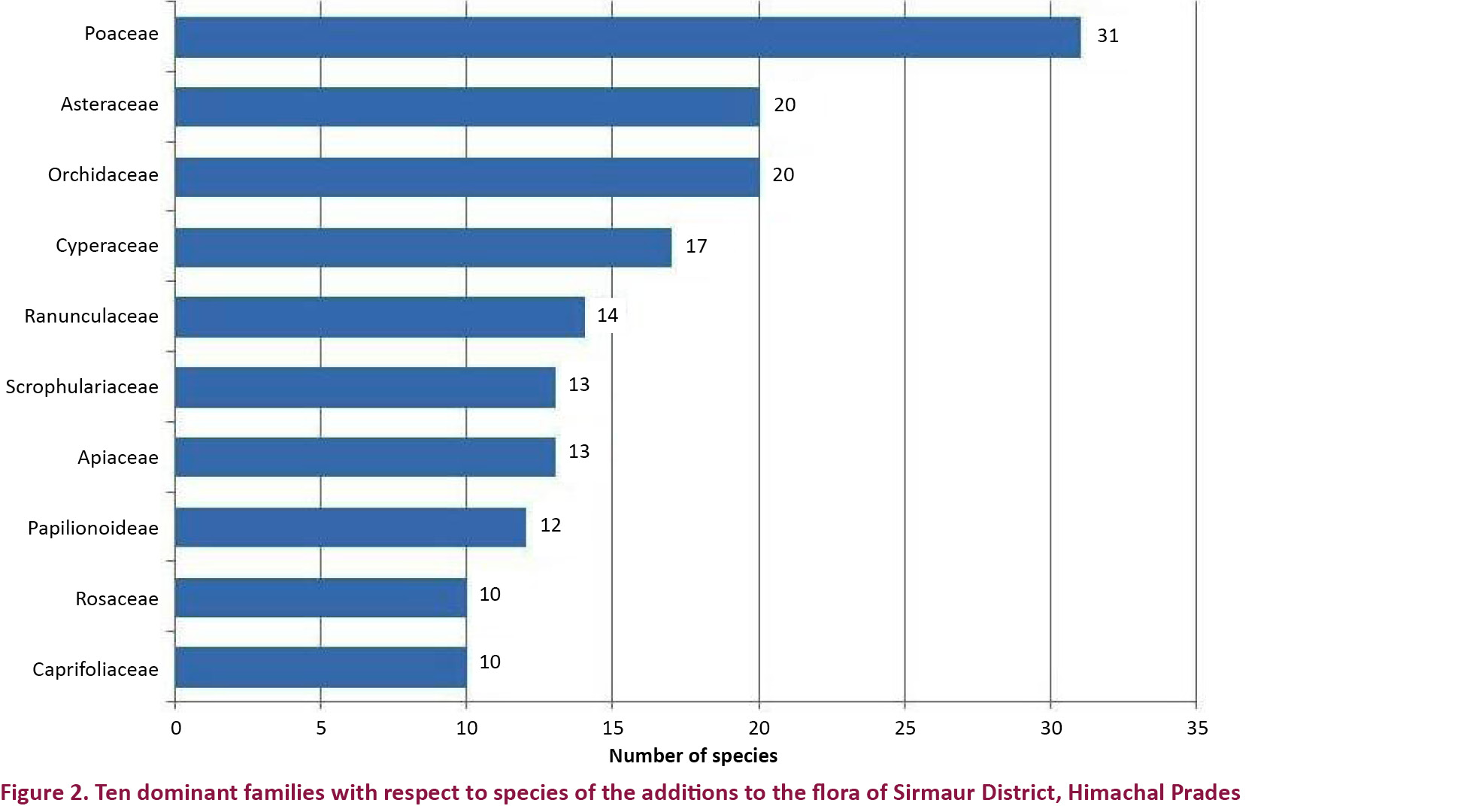
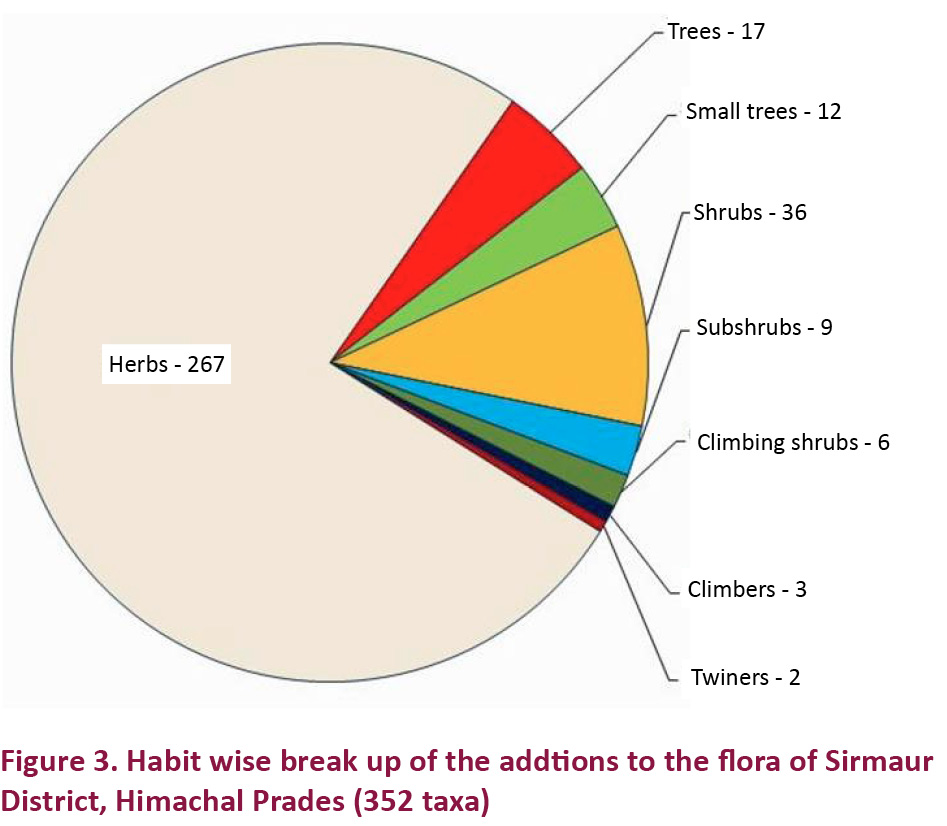
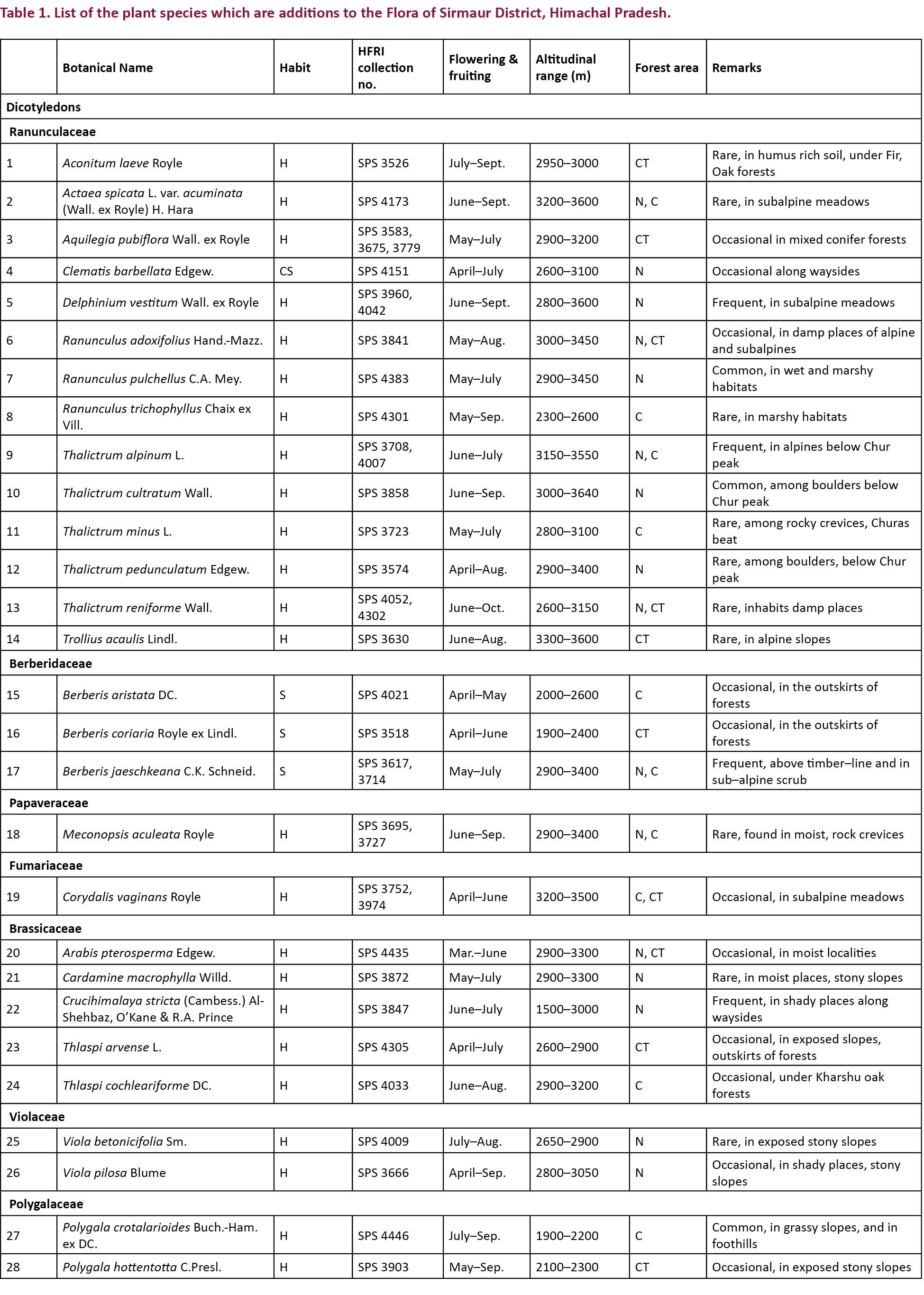
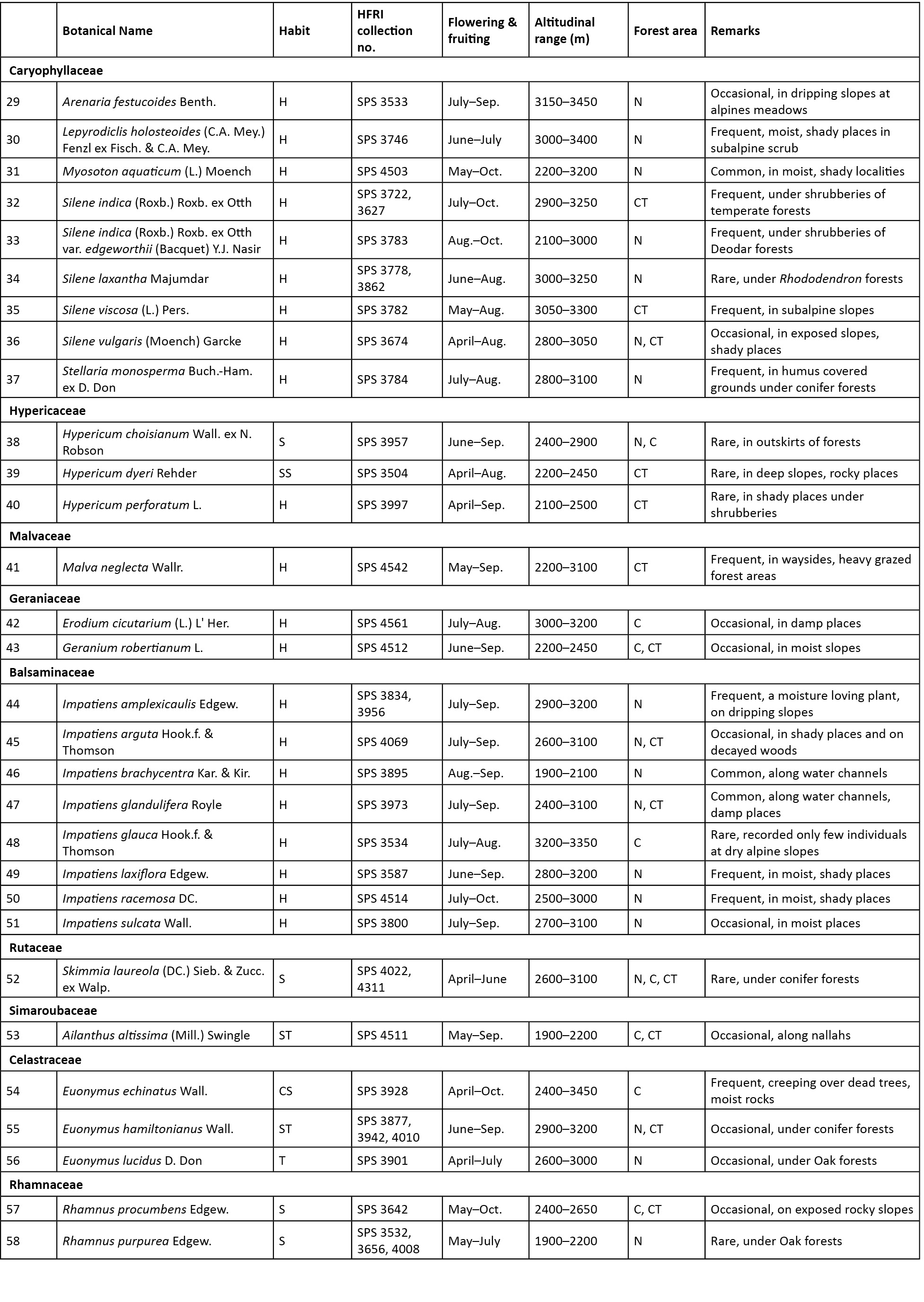
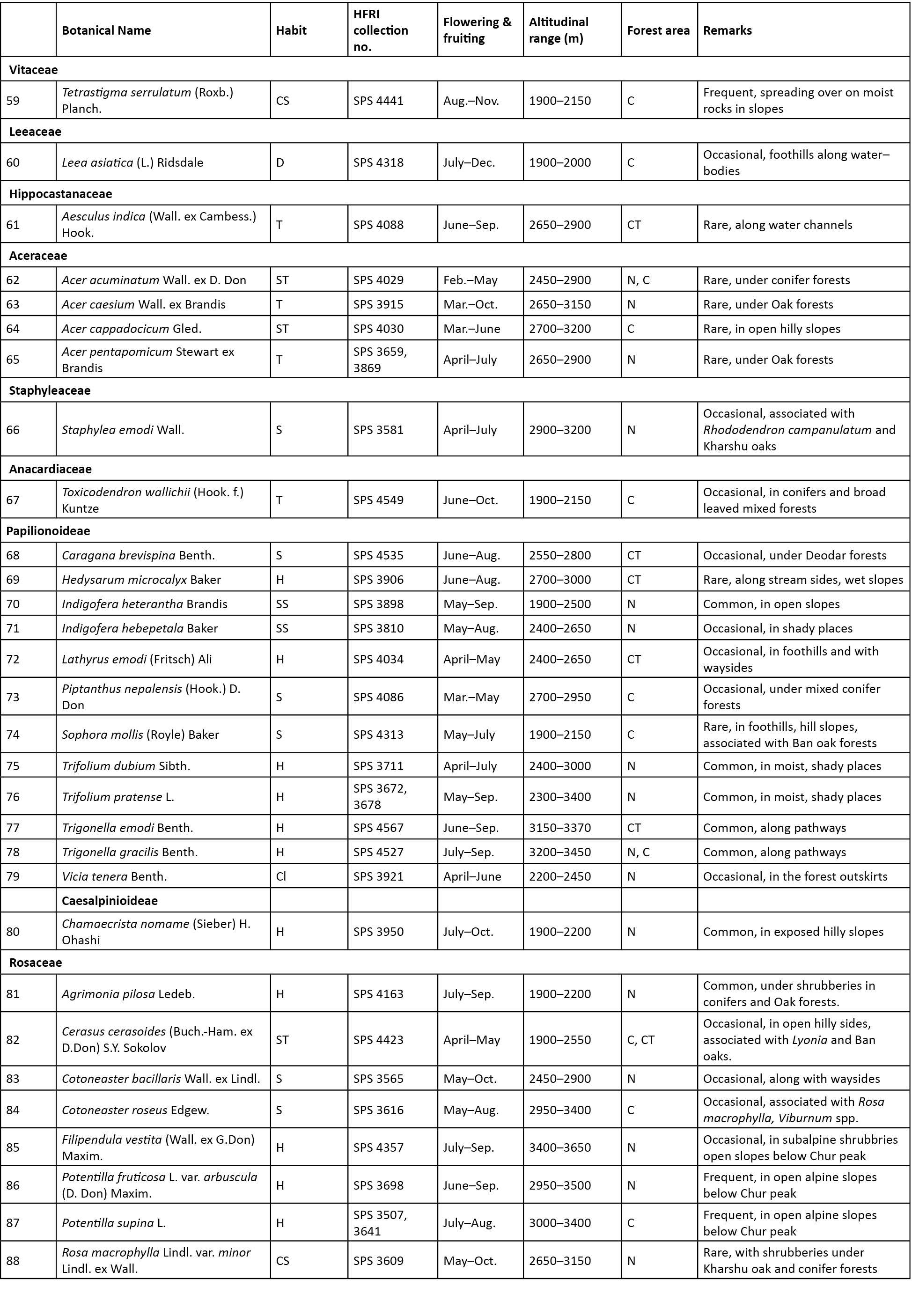
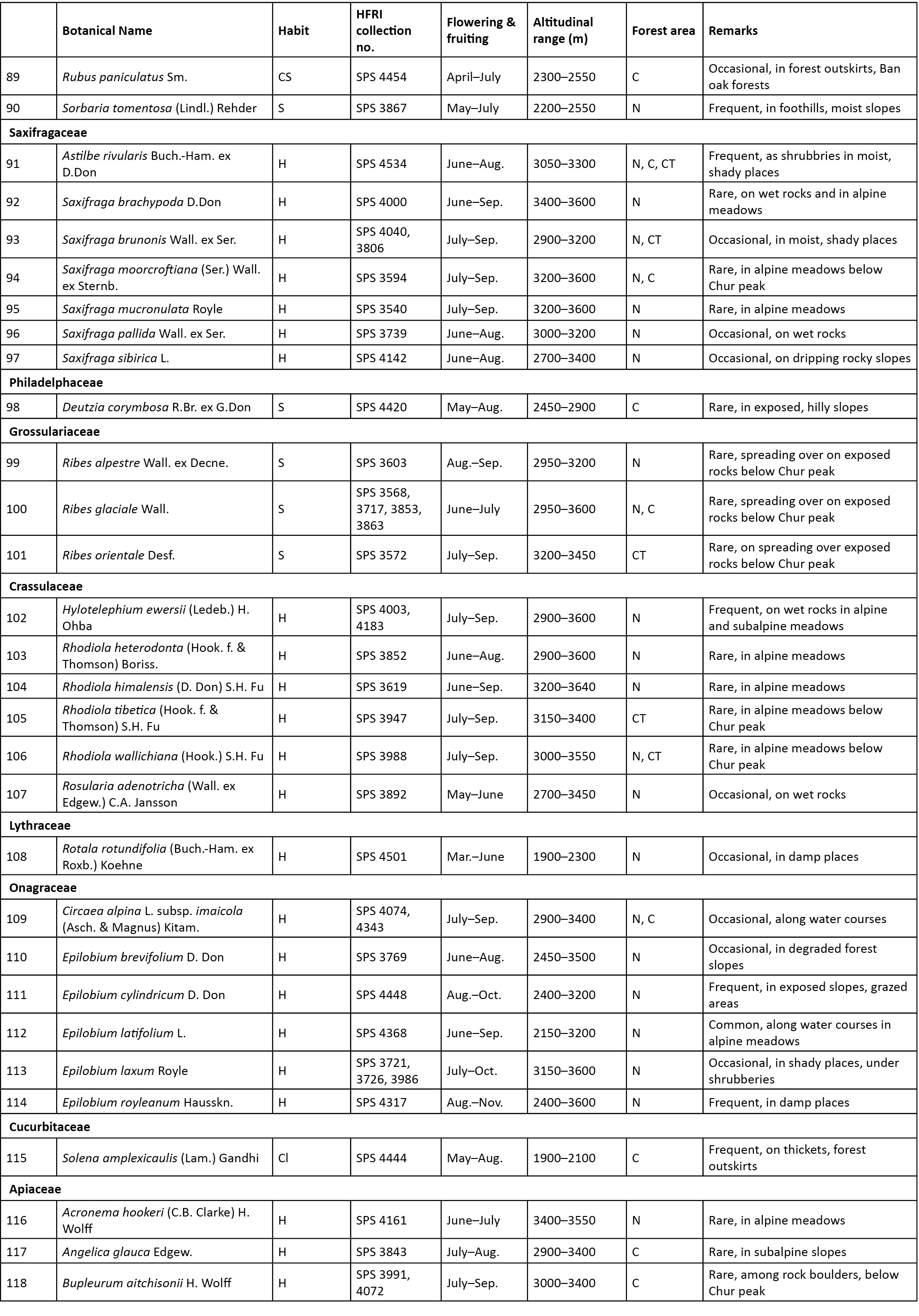
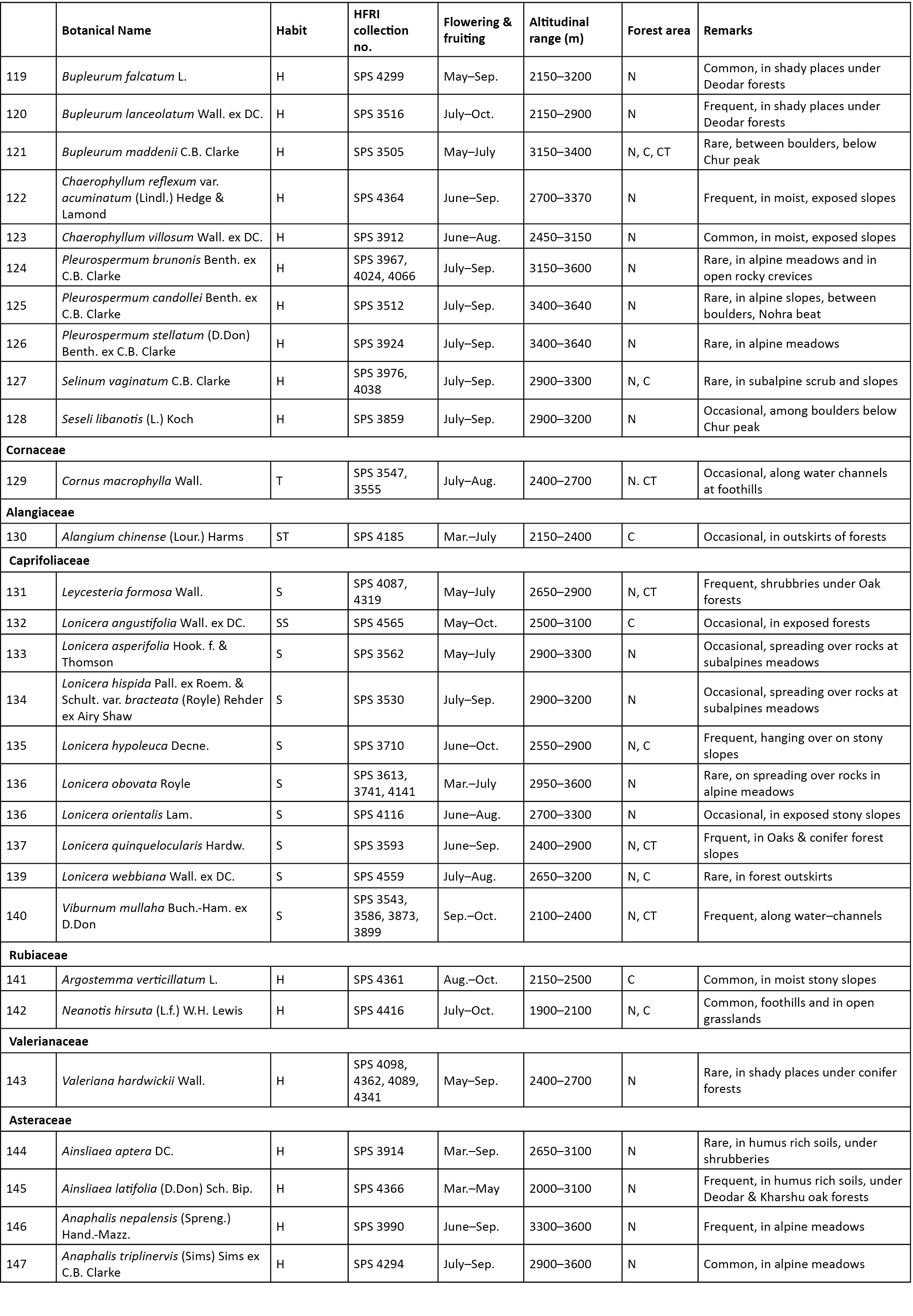
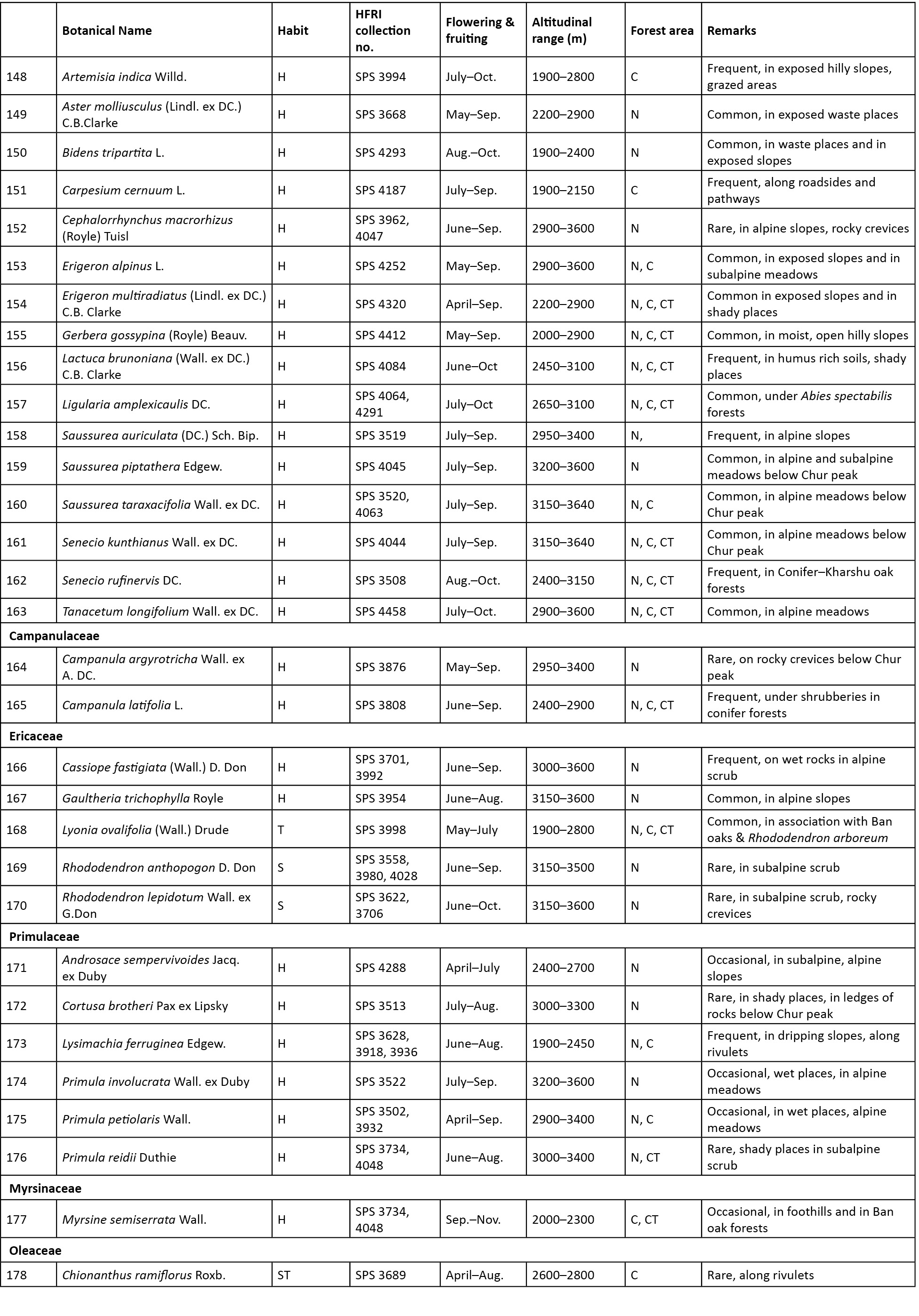
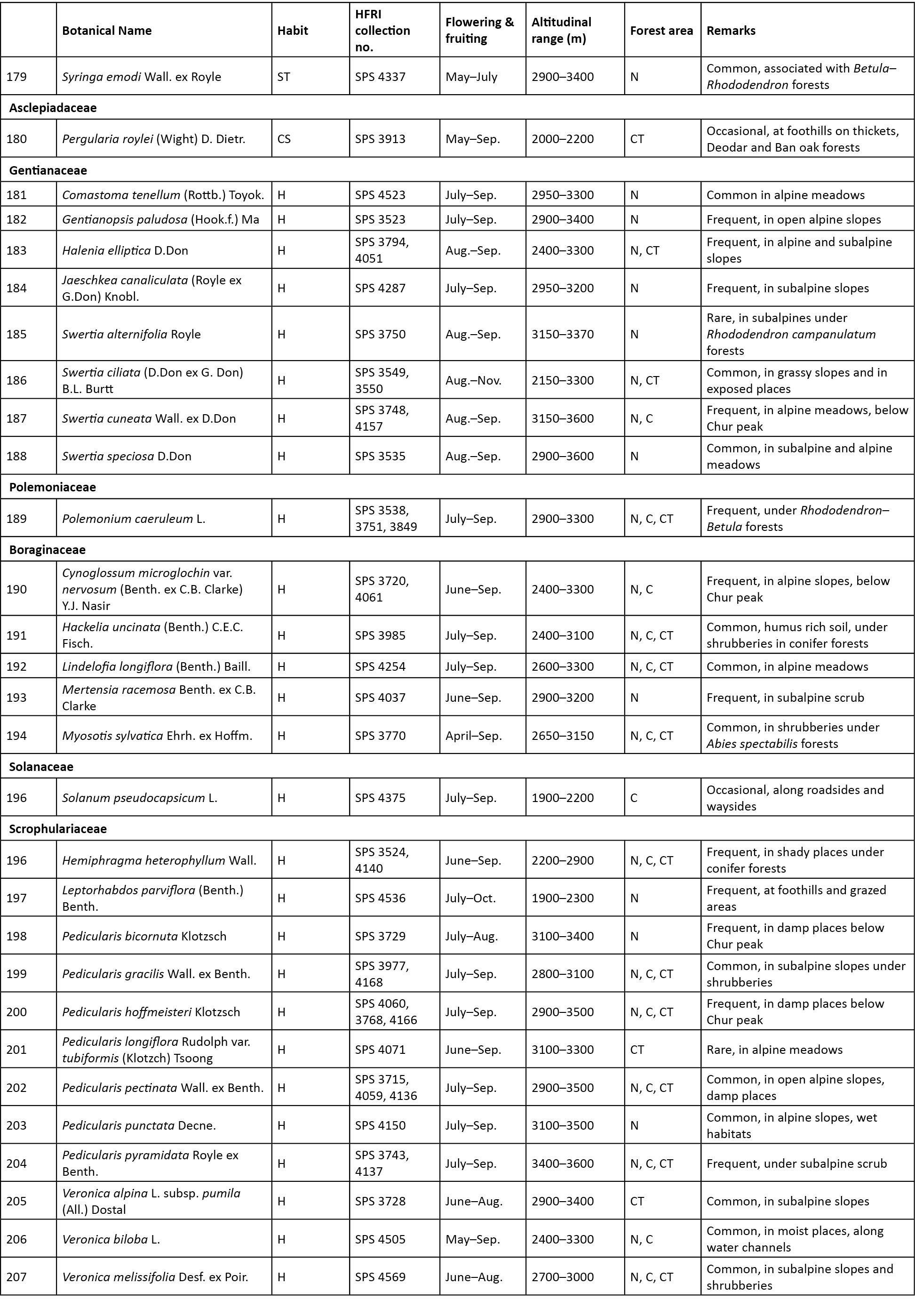
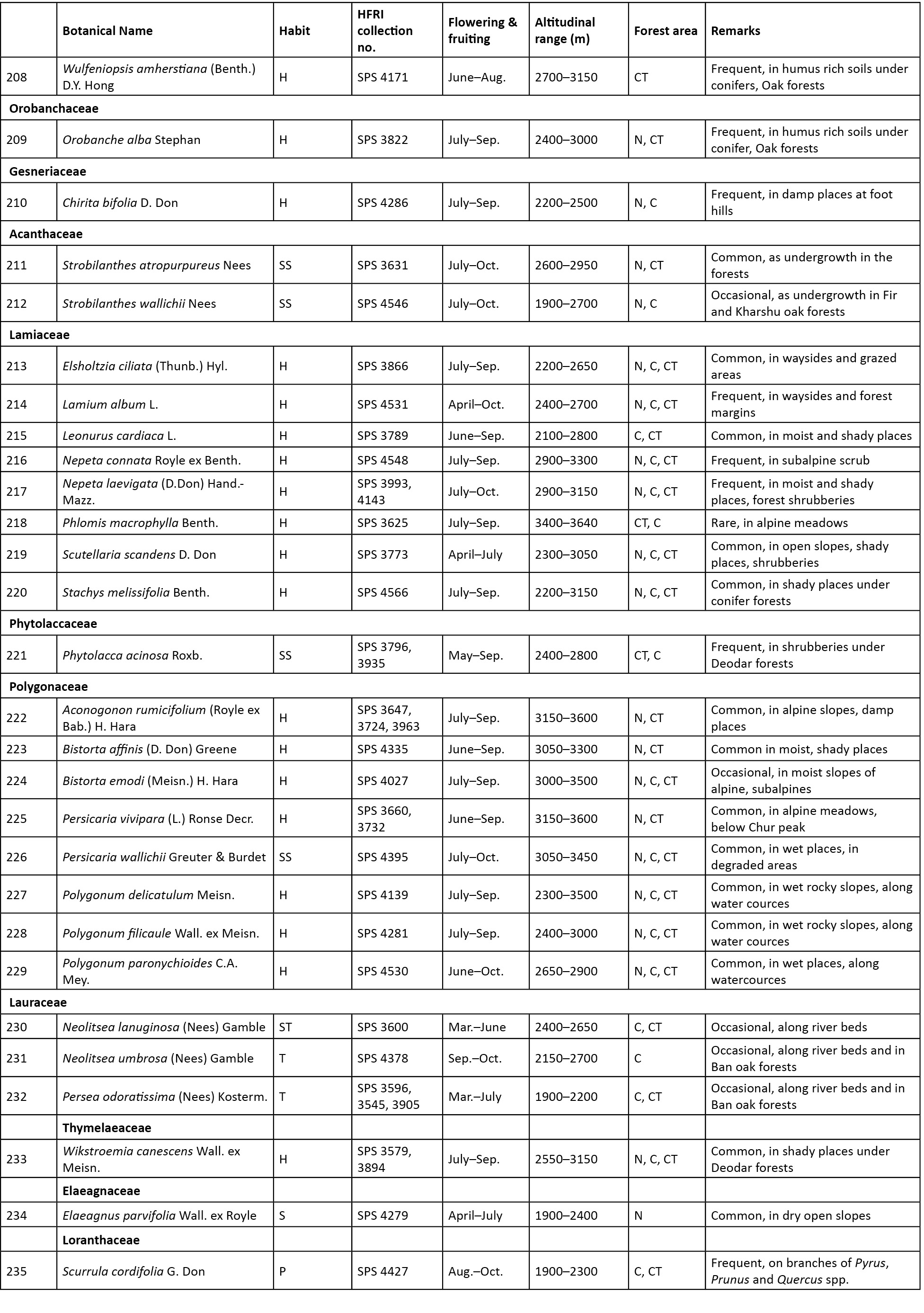
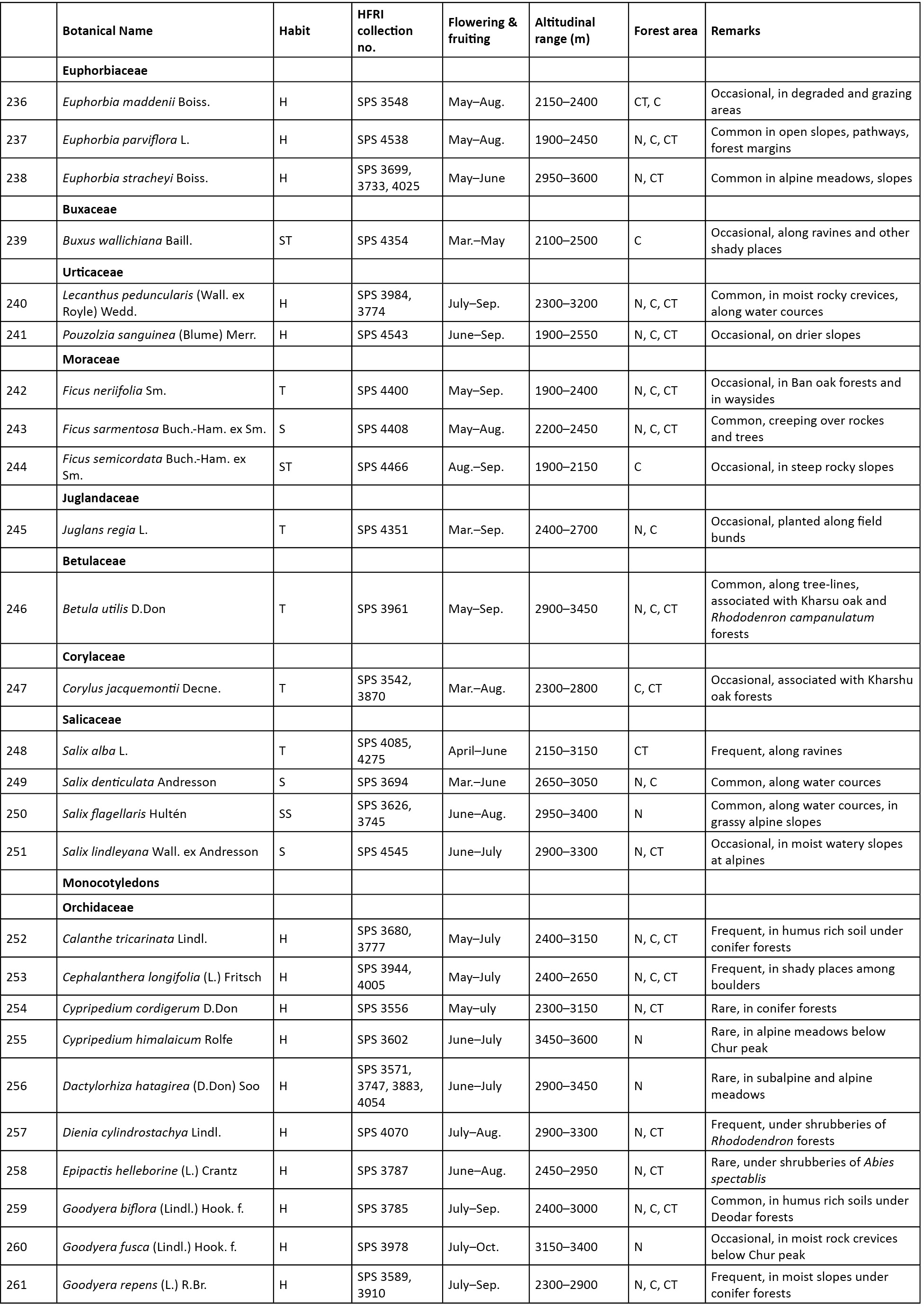
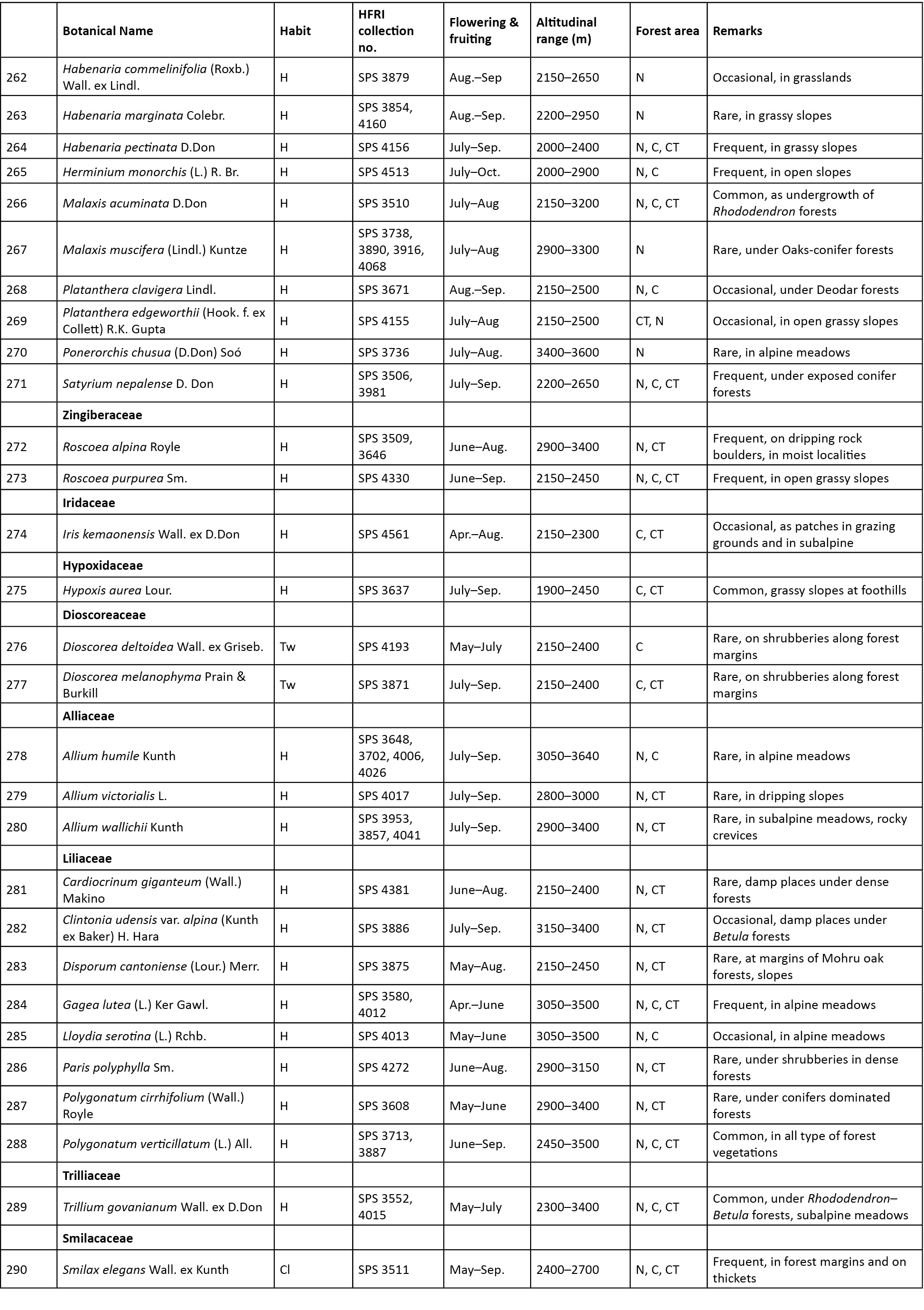
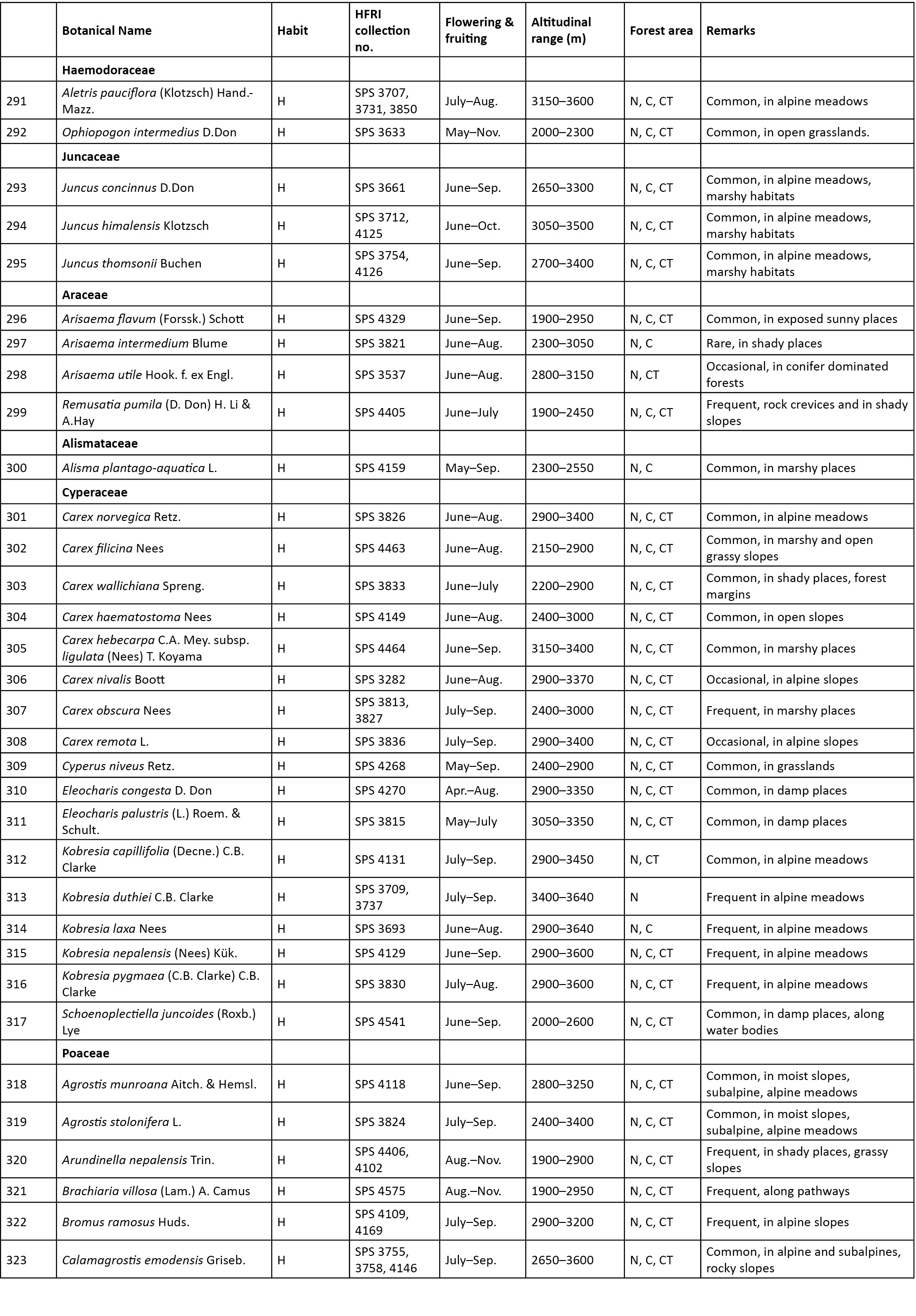
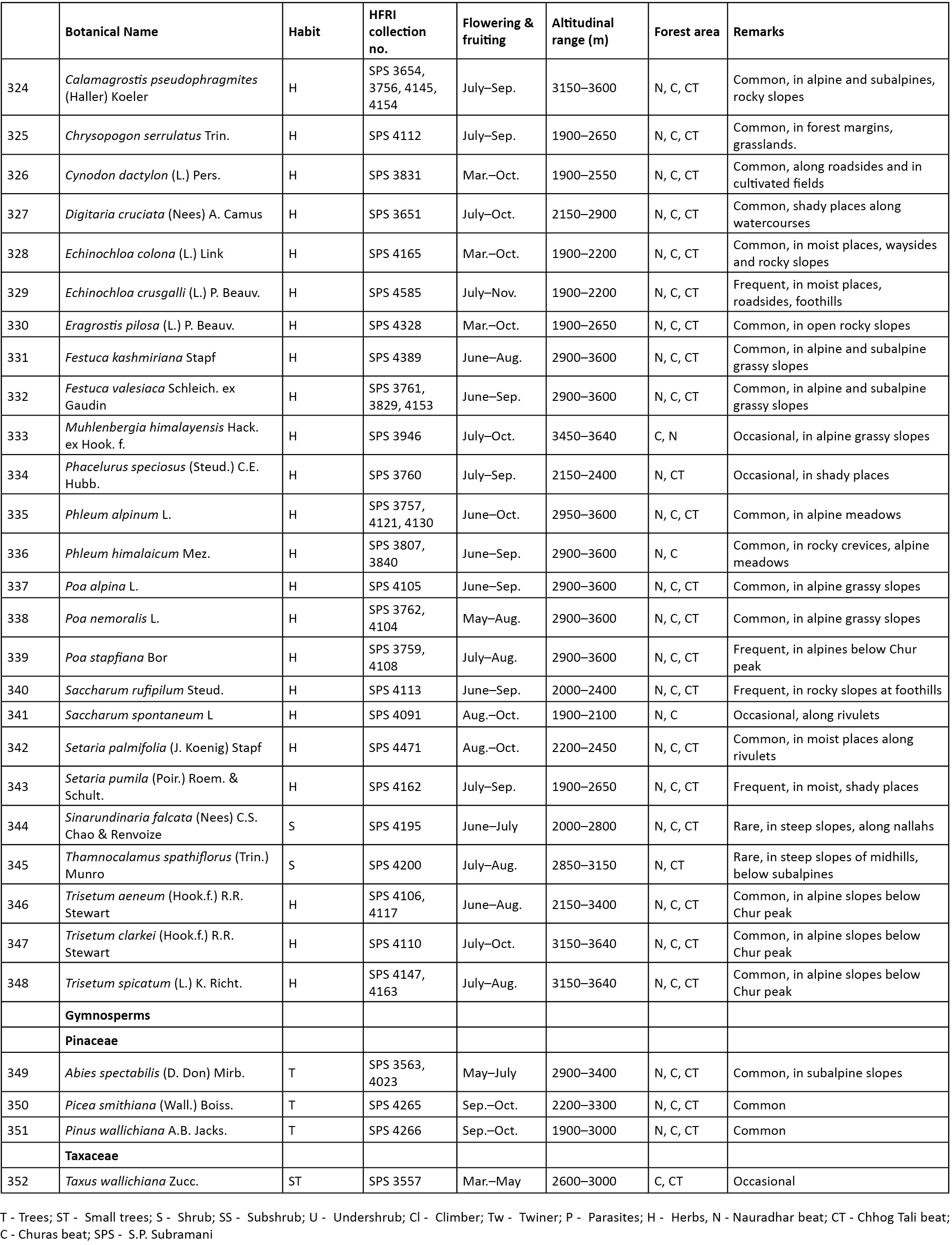
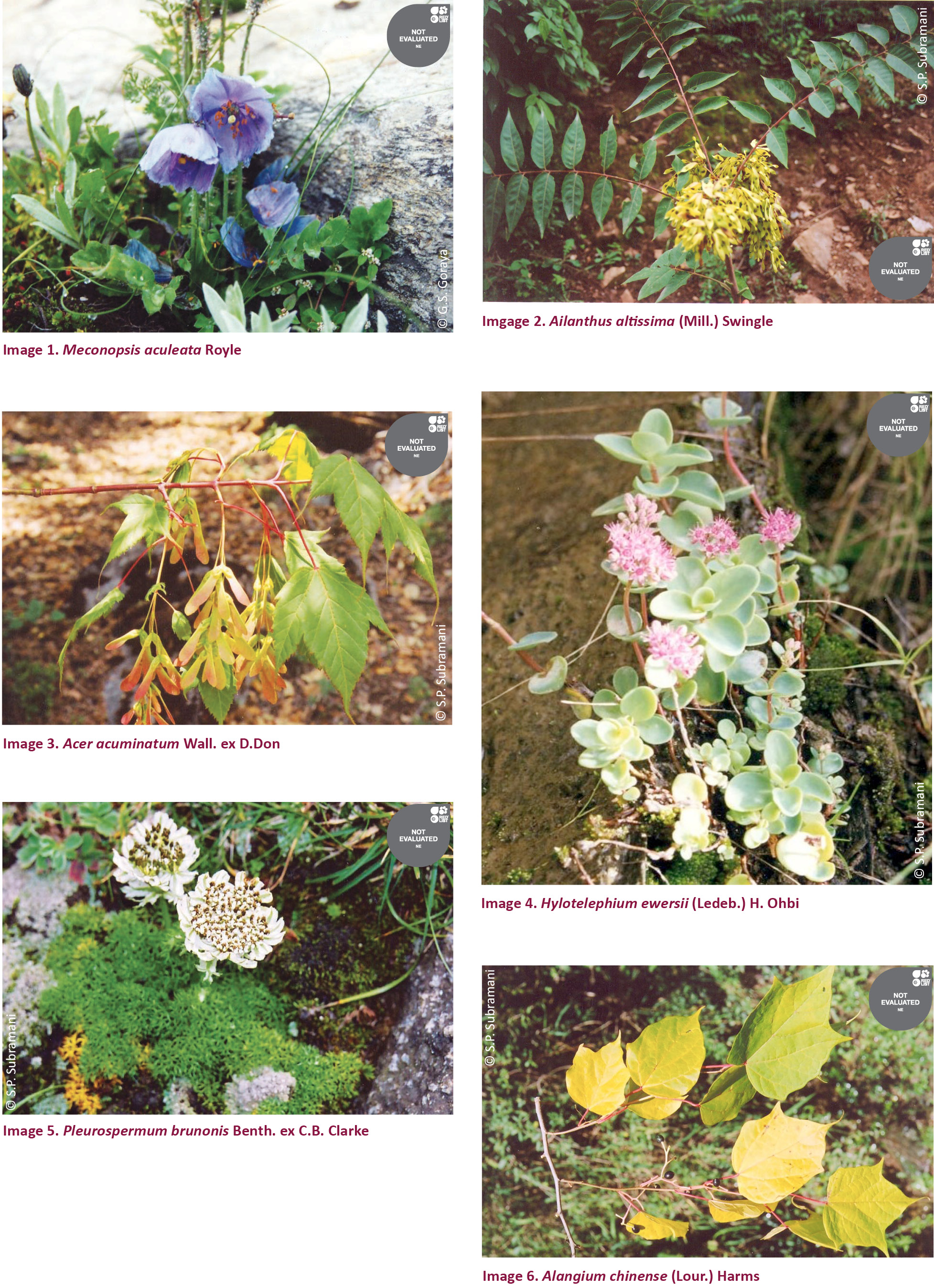
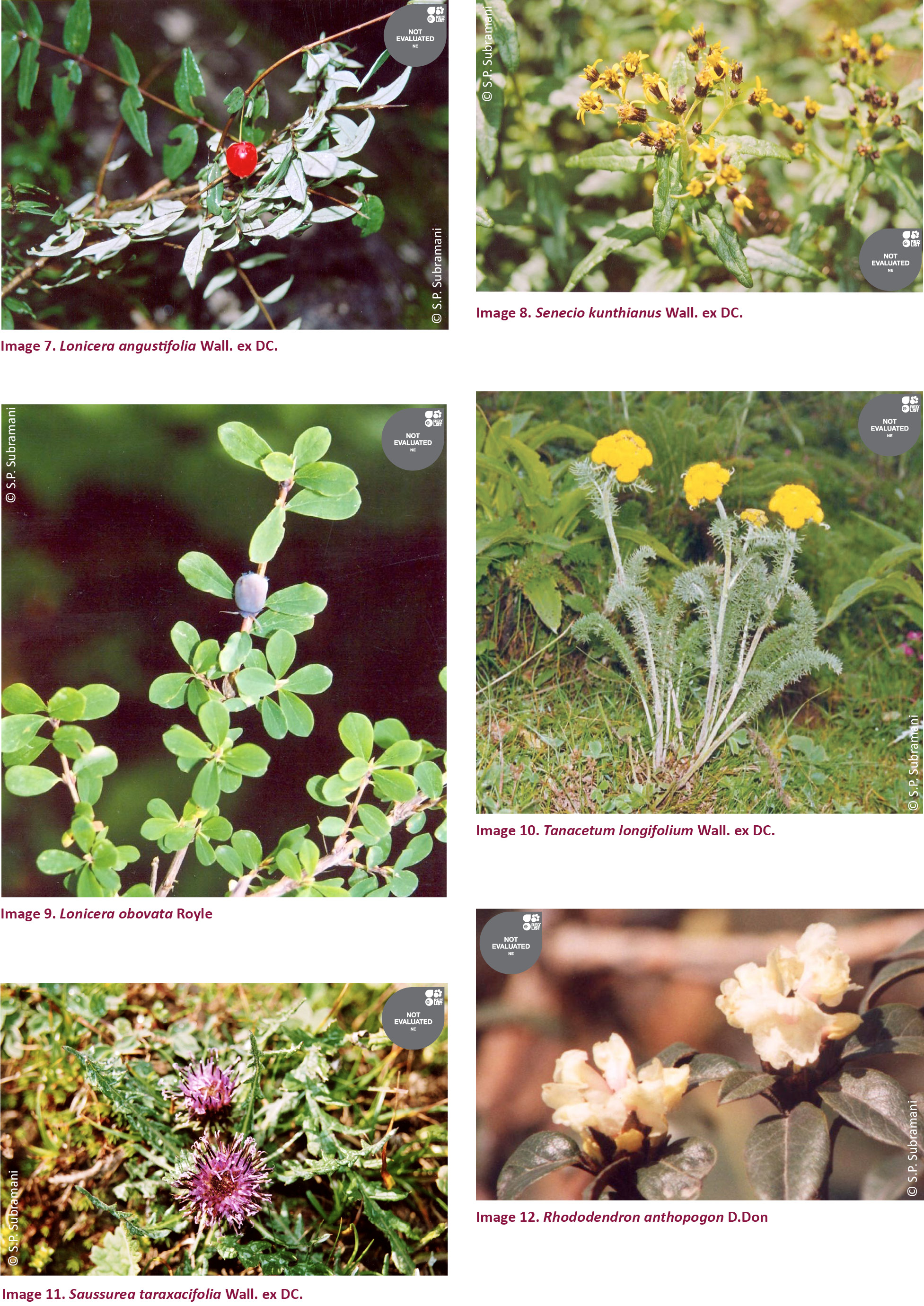
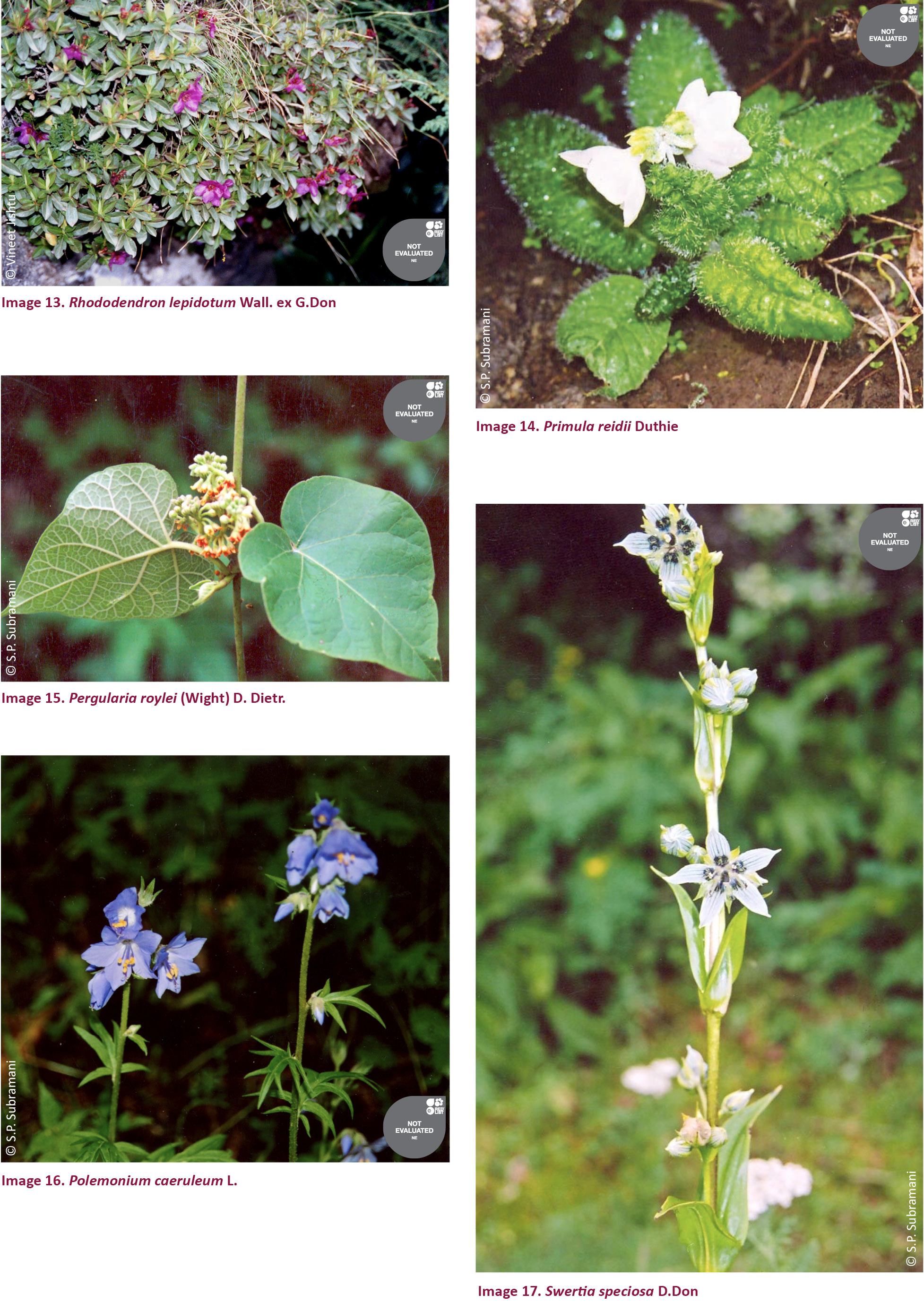
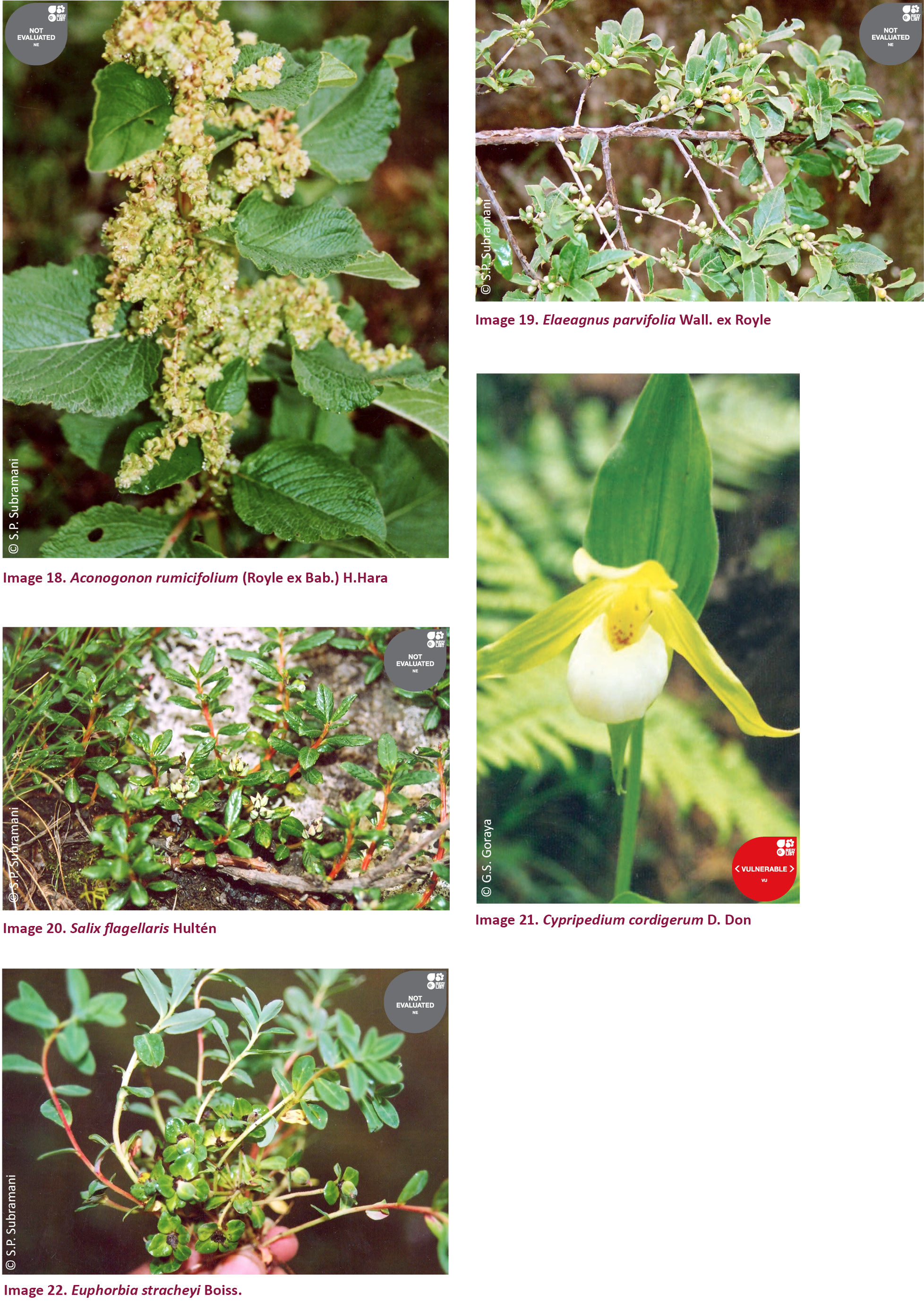
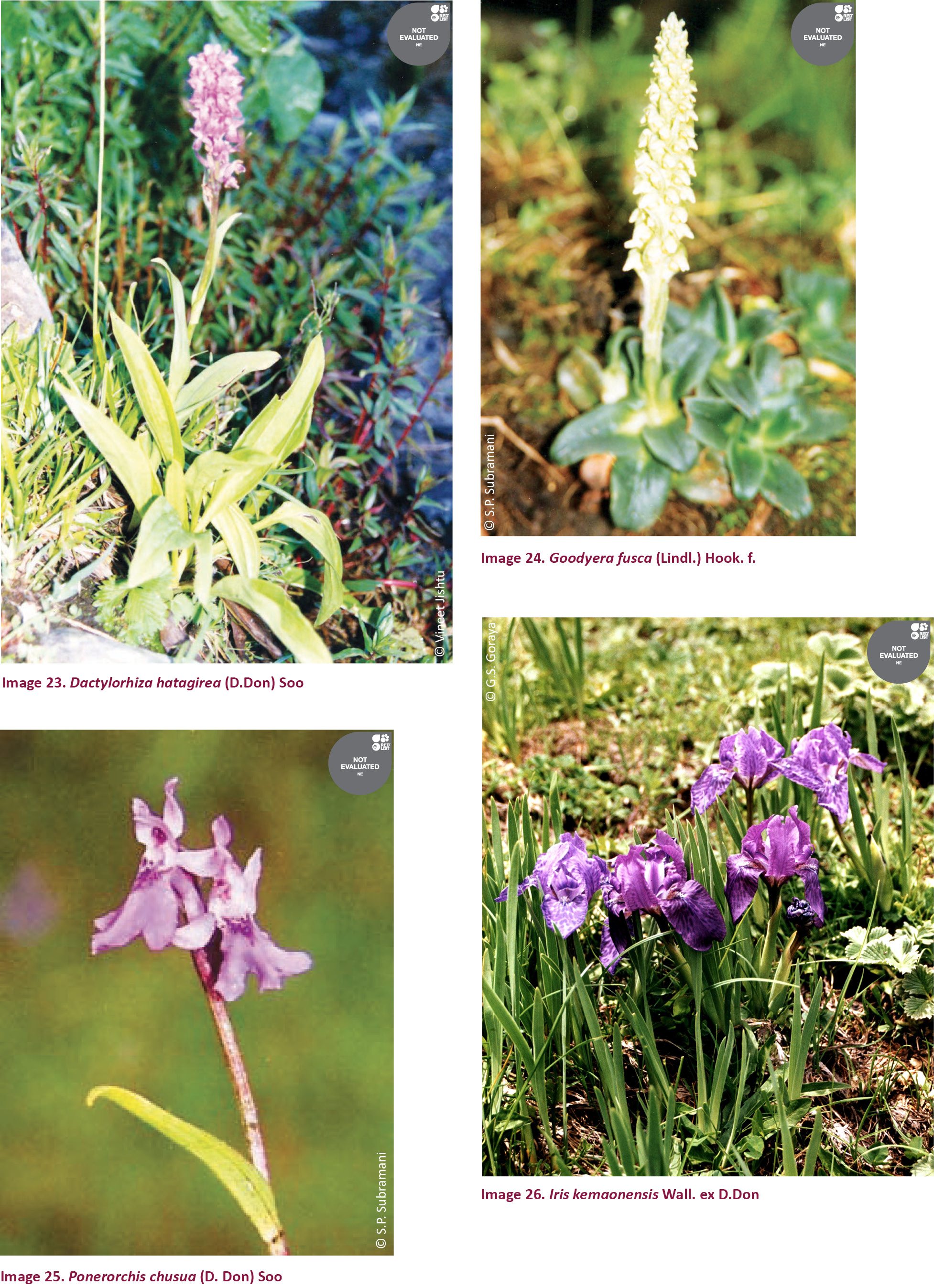
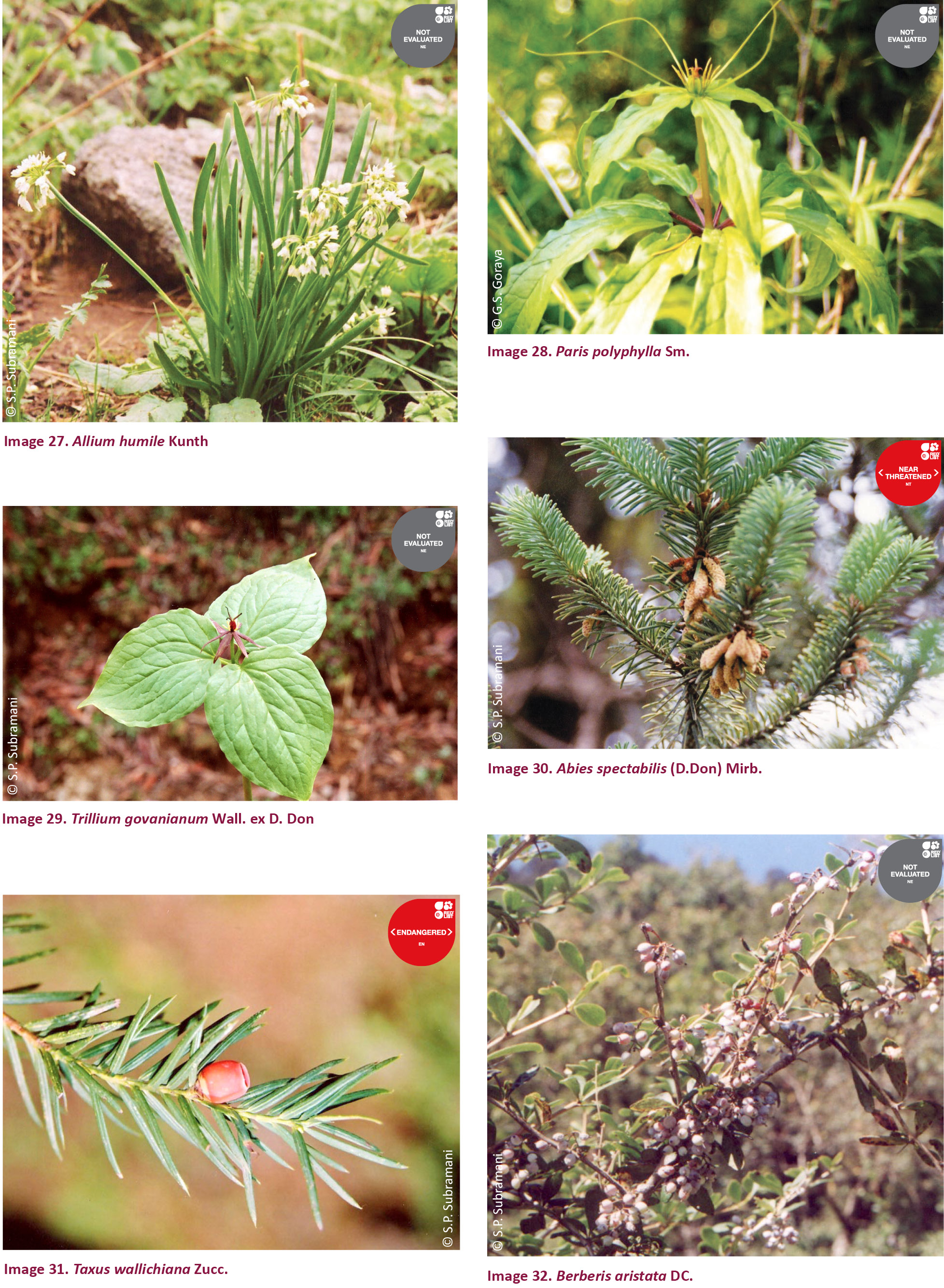
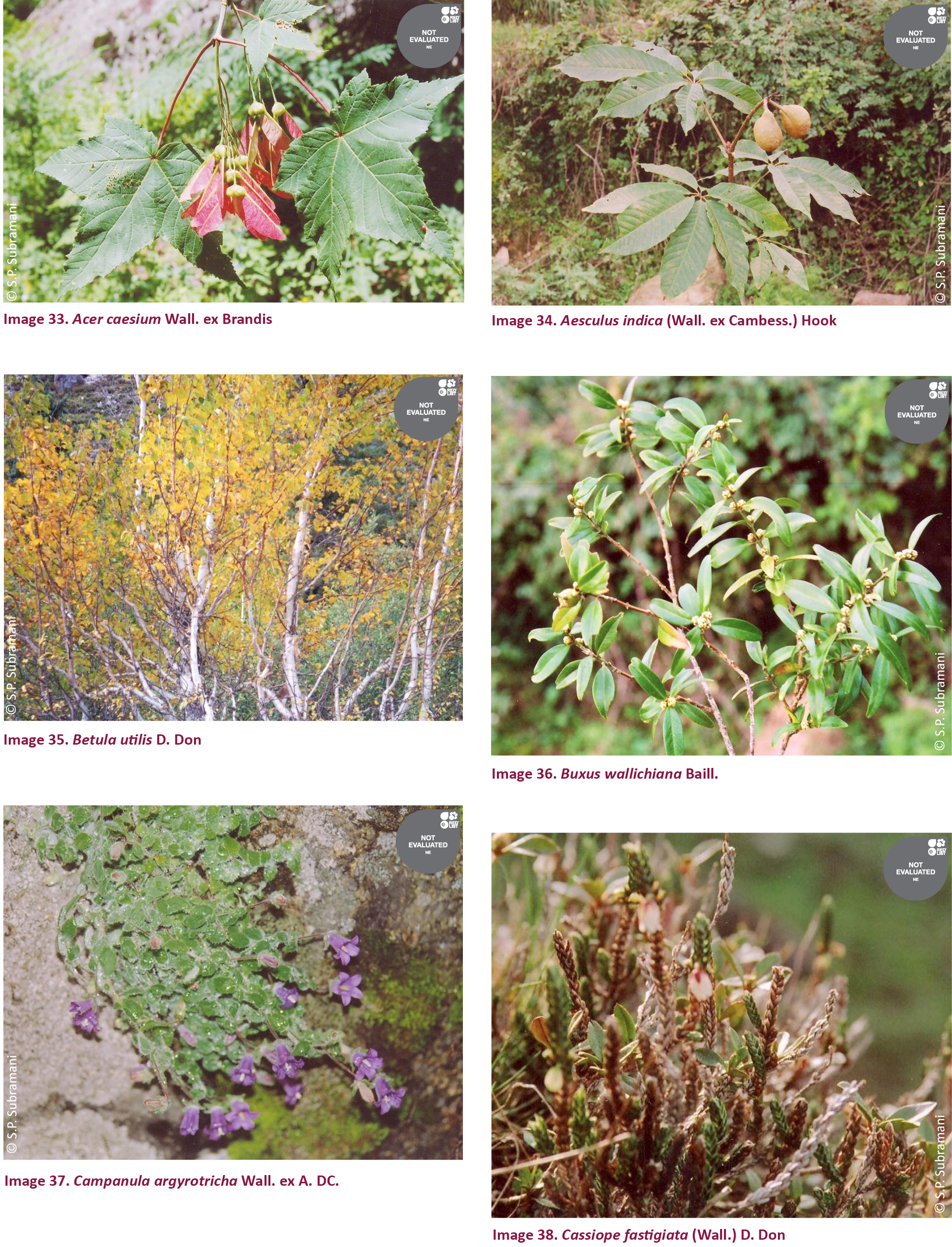
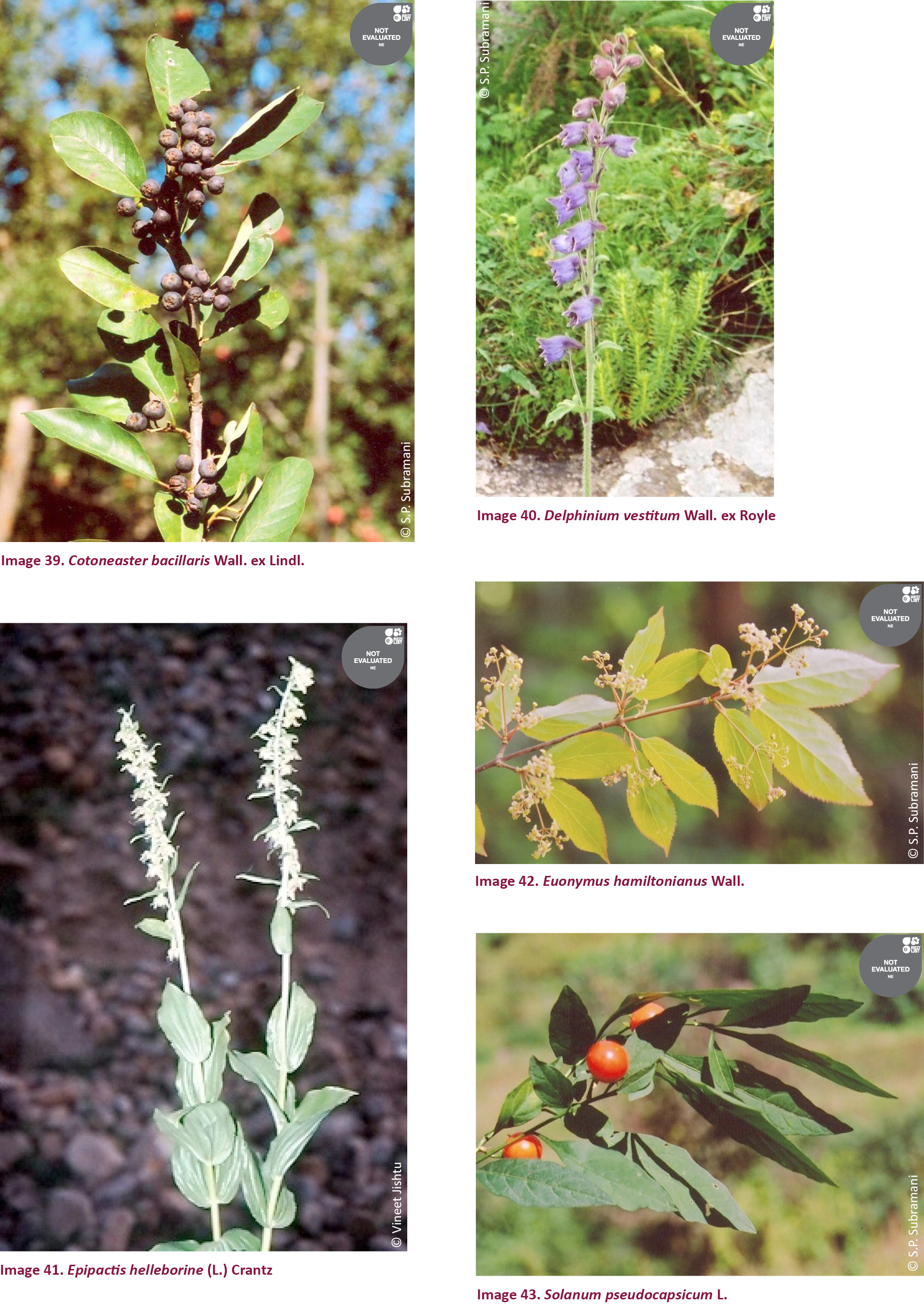
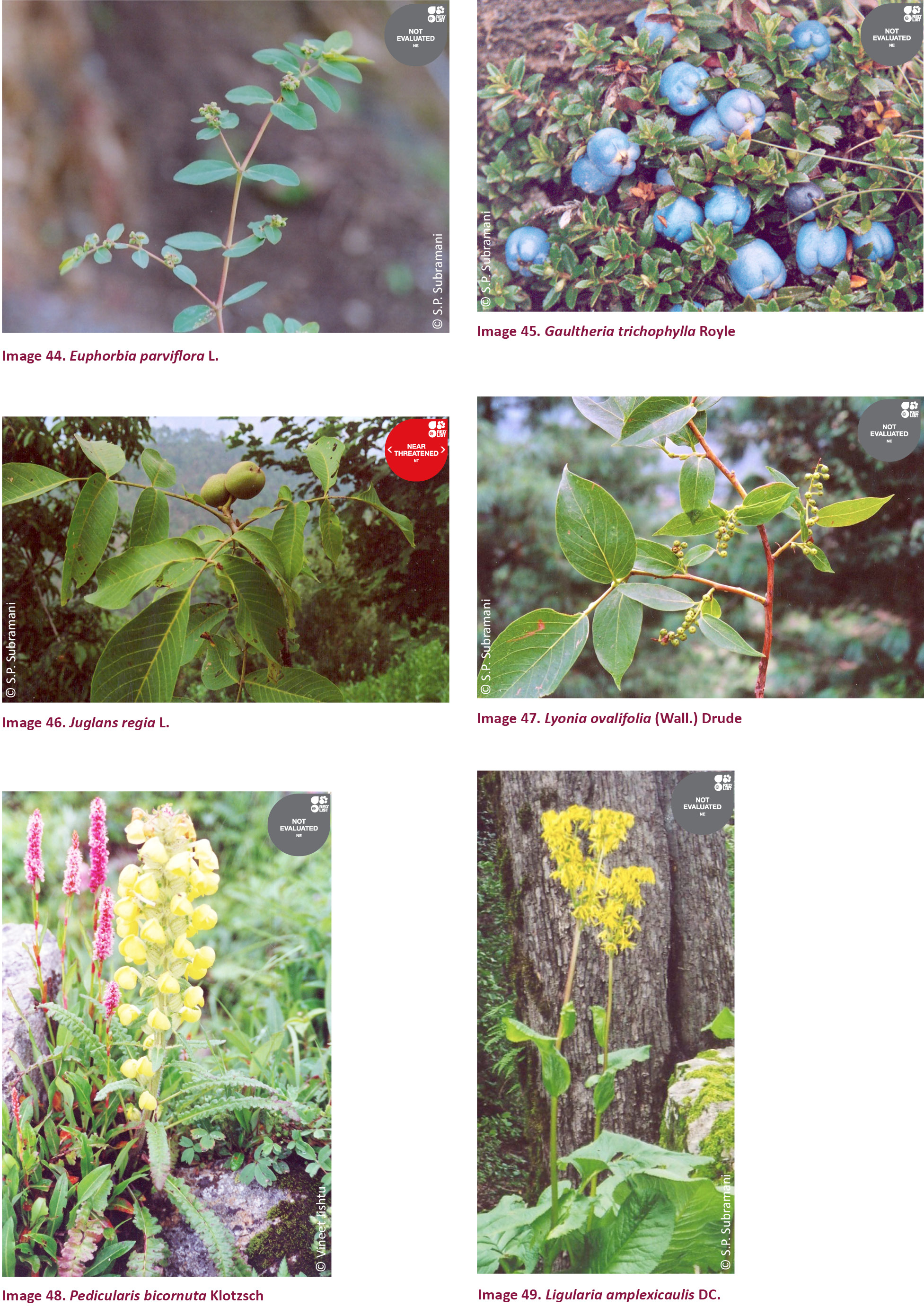
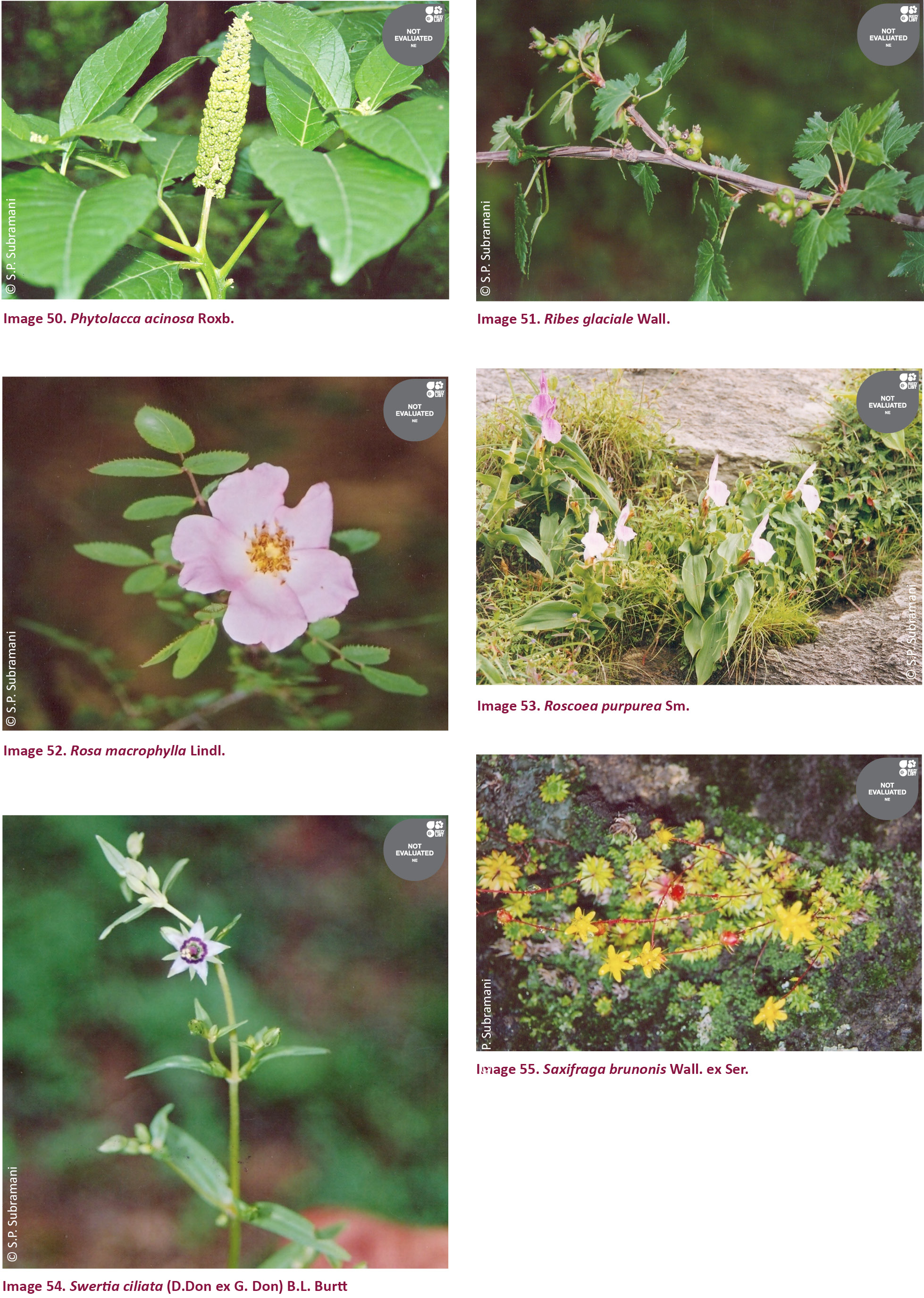
References
Anonymous (1994–95). Revised Working Plan for the Forests of Chopal Forest Division, Himachal Pradesh. Vol.1: 356pp.
Anonymous (2005–06). Revised Working Plan for the Forests of Rajgarh Forest Division, Himachal Pradesh. Vol.1: 387pp.
Chowdhery, H.J. & B.M. Wadhwa (1984). Flora of Himachal Pradesh, Analysis Vols. 1–3. Botanical Survey of India, Calcutta, 860pp.
Collett, H. (1902). Flora Simlensis: A Handbook of the Flowering Plants of Simla and the Neighbourhood. Thacker Spink and Co., Calcutta, 652pp.
Gupta, H. (1998). Comparative studies on the medicinal and aromatic flora of Churdhar and Rohtang areas of Himachal Pradesh. MSc Thesis. Dr. Y.S. Parmar University of Horticulture and Forestry, Nauni, Solan (unpuplished).
Holdgate, M. (1999). The Green Web - A Union for World Conservation. Earthscan, London, UK.
Karthikeyan, S. (2009). Flowering Plants of India in 19th and 21st Centuries - comparison, pp. 19–30. In: Krishnan, S. & D. Bhat (eds). Plant and Fungal Biodiversity and Bioprospecting. Boradway Book Centre, Goa.
Kaur, H. & M. Sharma (2004). Flora of Sirmaur (Himachal Pradesh). Bishen Singh Mahendra Pal Singh, Dehra Dun, 770 pp.
Khan, M.S. & S.A. Bhagwat (2010). Protected areas: a resource or constraint for local people? - A study at Chitral Gol National Park, North-West Frontier Province, Pakistan. Mountain Research and Development 30(1): 14–24.
Kumar, N. (2004). Studies on the distribution and importance of medicinal and aromatic plants of Nahan area, District Sirmaur (H.P.). MSc Thesis. Dr. Y.S. Parmar University of Horticulture and Forestry, Nauni, Solan (unpublished), 226pp.
Nair, N.C. (1977). Flora of Bashahr Himalaya. International Bioscience Publishers, Hissar, 360pp.
Nayar, M.P. (1996). Hot Spots of Endemic Plants of India, Nepal and Bhutan. Tropical Botanic Garden and Research Institute, Palode, Thiruvananthapuram, 252pp.
Nayar, M.P. & A.R.K. Sastry (eds) (1987, 1990). Red Data Book of Indian Plants. Vol.1 - (1987) & Vol. 3 - (1990). Botanical Survey of India, Howrah.
Polunin, O. & A. Stainton (1984). Flowers of the Himalaya. Oxford University Press, New Delhi, 580pp.
Singh, J.S. (2002). The biodiversity crisis: A multifaceted review. Current Science 82: 638–647.
Thomas, P. & A. Farjon (2011). Taxus wallichiana. The IUCN Red List of Threatened Species. Version 2014.2. <www.iucnredlist.org>. Downloaded on 11 October 2014.
Ved, D.K., G.K. Kinhal, K. Ravikumar, V. Prabhakaran, U. Ghate, R.V. Sankar & J.H. Indresha (eds.) (2003). Report of the Conservation and Assessment Management Prioritization for the Medicinal Plants of Jammu and Kashmir, Himachal Pradesh and Uttaranchal. FRLHT, Bangalore, 206pp.